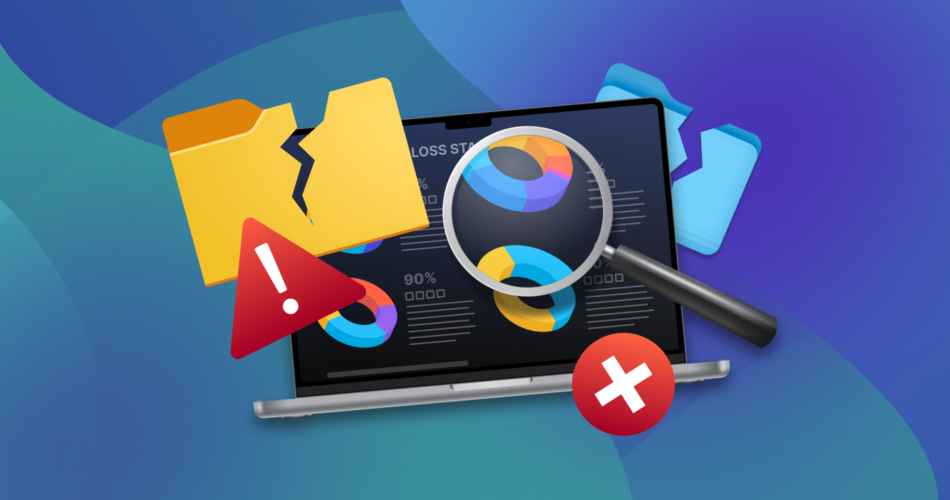Data loss is the whole reason online resources like ours exist. No matter whether we’re talking about multi-billion-dollar corporations or home users, the risk is always there. Just skim the headlines, there’s always something. Not long ago, Atlassian warned of a critical security flaw that could lead to “significant data loss” for customers, just weeks after state-backed hackers had already targeted its products. And if that’s happening at their level, it’s easy to see how vulnerable the average user might be.
With corporations, it’s clear, they’ve got dedicated teams, backup systems, security audits. But what about everyday people? What do they do when their files disappear, or better yet, before that happens? That’s exactly what we set out to learn.
Handy Recovery Advisor surveyed 1,000 U.S. nationals to get a clearer picture of how everyday users handle data loss prevention. The results may surprise you. We’ll break down 12 standout stats in a moment, but first, here are a few key takeaways that caught our attention right away.
- Over 70% of users have lost data at least once. It’s something most people go through sooner or later.
- Accidental deletion (34%) and hardware failure (30%) cause most data loss. In other words, both human error and tech issues play a big role.
- Nearly 60% of users who never lost data rely on cloud storage.
- More than half try DIY recovery first, and about 79% of those succeed in getting files back.
- Tech skills don’t guarantee safety; experts face higher risks due to handling more devices and complex tasks.
Data Loss and Recovery Survey Findings
Now let’s go through each of the 12 findings in more detail. Some of these data loss statistics might seem obvious at first glance, but there’s more going on underneath. The patterns, the numbers, and even the small surprises help paint a bigger picture of how everyday users actually experience data loss (and what they try to do about it).
We were surprised by how many people had dealt with data loss, and how many tried to fix it themselves. Awareness is up, but knowing the right recovery steps still trips people up.
1. Over 70% of users have experienced data loss at least once
Out of the 1,000 people we surveyed, only 293 said they’ve never lost data. That means 70.7% have. Whether it was a deleted folder, a fried hard drive, or a syncing mishap, most people have been through it at least once. These data loss statistics show that losing data isn’t rare – it’s practically a rite of passage.
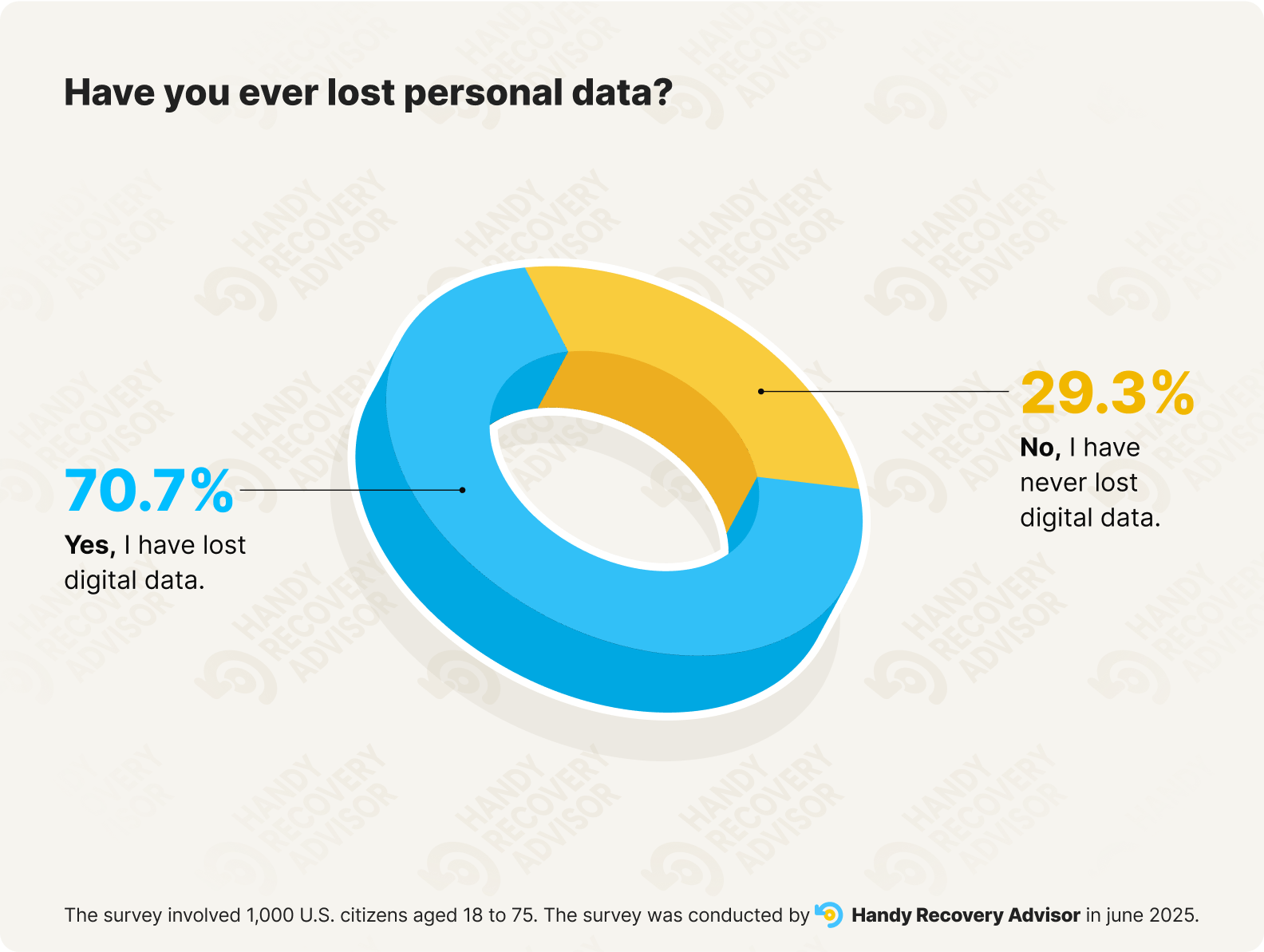
Nothing about this surprises us, but it’s nice to put numbers to what we see basically every day.
2. Accidental data deletion is the leading cause of data loss, accounting for around 34% of cases
As to the most common cause of data loss – accidental deletion takes the crown, responsible for about 34% of cases. Right behind it, hardware failure accounts for another 30%. So, between people hitting the wrong button and devices deciding to quit, that’s two-thirds of all incidents.
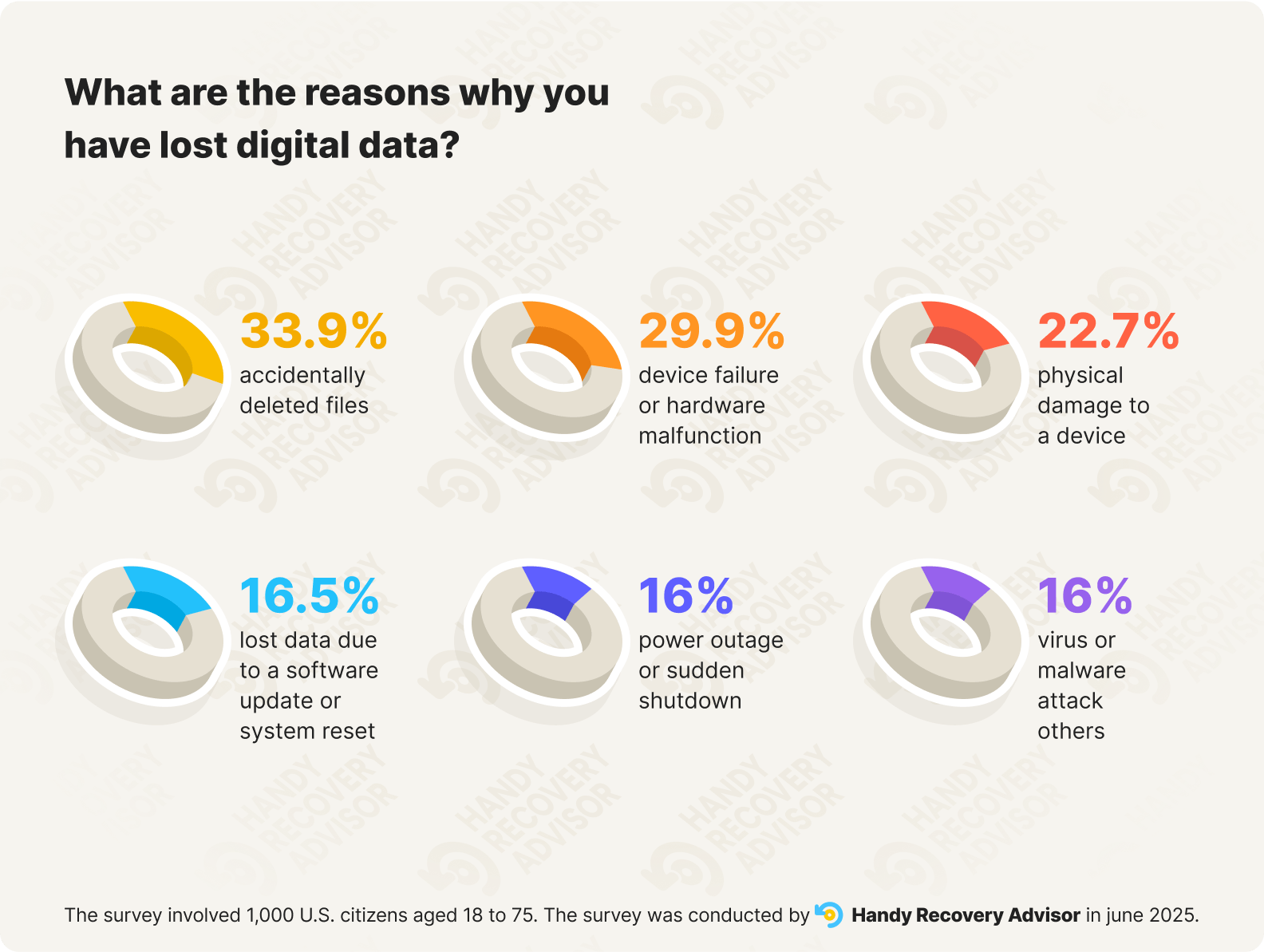
So it’s not all human error, and it’s not all on the machines either. Data loss doesn’t play favorites, it happens when habits slip or tech fails, and sometimes both at once.
3. Data loss is more common in areas prone to natural disasters
Out of everyone we surveyed, about 52% said they don’t live in areas known for natural disasters. But when we looked closer, the numbers shifted. In high-risk regions (think floods, wildfires, frequent power outages) 73% had experienced data loss. In lower-risk areas, that number dropped to 68%.
Not a massive gap, but enough to notice. It suggests that environmental risk factors, like unstable power or water damage, do play a role in data vulnerability. You can be careful, but when nature gets involved, backups matter even more.
4. Mac users experience data loss 30% more often than Windows users
This was a surprise for some of us. Despite Apple’s reputation for reliability, the numbers tell a different story. Only 16.38% of Mac users in our survey said they’ve never lost data. For Windows users, that number was noticeably higher – 23.26%.
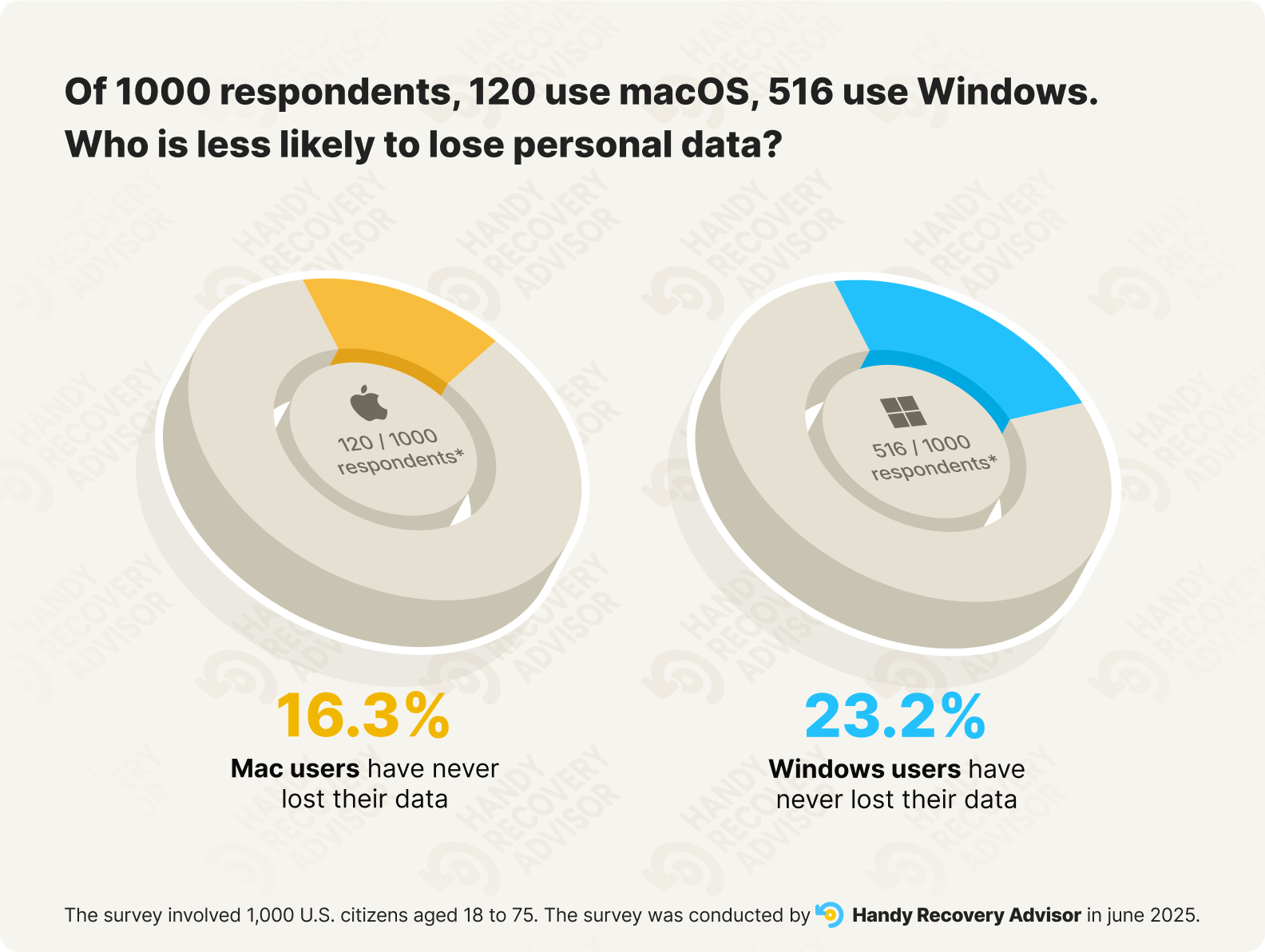
Another way to put it: Mac users experience data loss about 30% more frequently than Windows users, which adds an interesting layer to how we think about PC data loss statistics in general.
It doesn’t mean Macs are worse, but it does suggest that assumptions about built-in safety nets like Time Machine or iCloud might lead to a false sense of security.
5. Only 16% of users who faced data loss don’t back up
Here’s where things get interesting. Among users who’ve already experienced data loss, only 16% still don’t back up. Compare that to users who’ve never lost data (48% of them don’t back up at all).
It’s a clear pattern: once you lose something important, you’re way more likely to start taking backups seriously. But if you haven’t been burned yet, it’s easy to think it won’t happen to you.
That false sense of security is what leads to the riskiest habits.
6. DIY recovery is the first choice for more than half of the respondents
This one was absolutely no surprise to us, to see in numbers what we’ve known for years. When people lose data, their first instinct is to try to fix it themselves. Among those who experienced data loss, 35.7% turned to online sources like Reddit or tech forums for advice, while 17.8% jumped straight into using data recovery software.
Only 11.7% didn’t take any immediate action. Altogether, over 53% tried some kind of DIY solution before considering professional help.
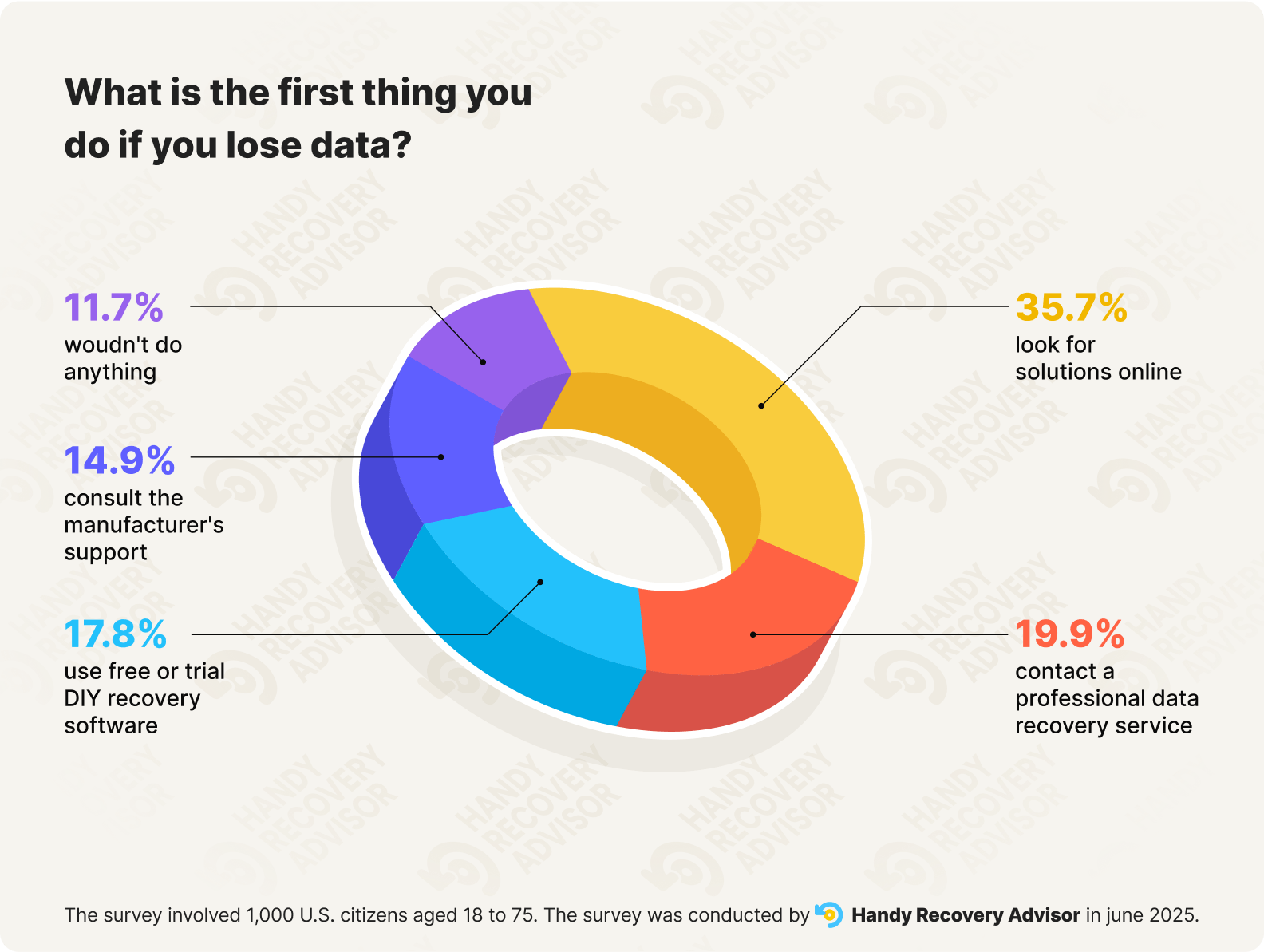
It’s a clear sign that self-reliant fixes still dominate (even when the situation’s serious). There’s no shortage of online guides (we make them, so we’d know) and recovery tools (both free and paid) that promise to bring your files back. And most people are willing to roll up their sleeves and give it a shot.
7. Among those who have recovered lost data, 60% attempted recovery on their own, while 34% sought professional help
This finding is a natural follow-up to the previous one, and it reinforces the same point.
Our data recovery statistics show that out of the 339 users who successfully recovered their lost data, 60% did it themselves, either by hunting down solutions online or using recovery software. Only 34% turned to professional services.
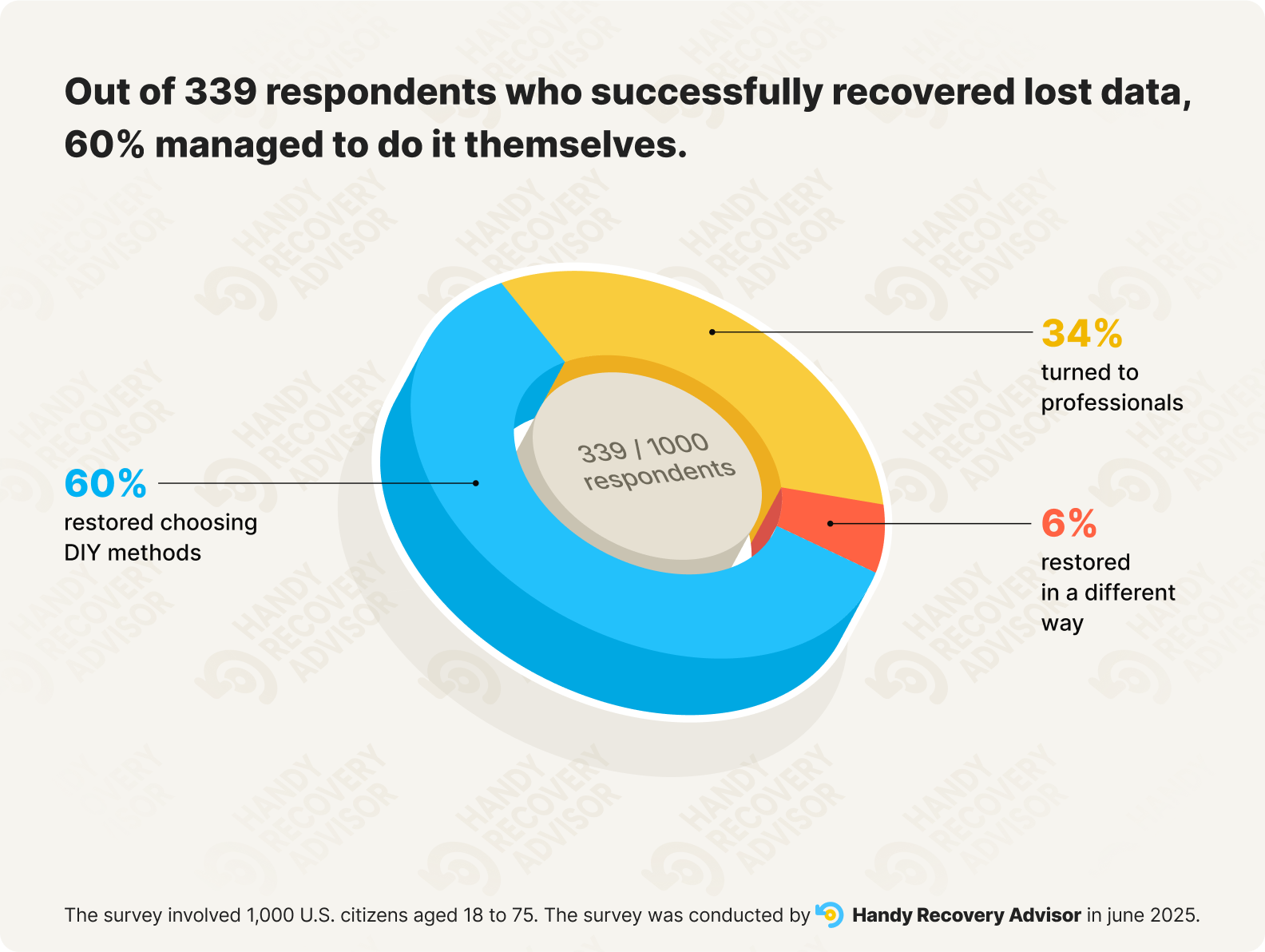
So not only do most people try DIY recovery first, a lot of them actually pull it off. It shows that going the solo route often works well enough.
It doesn’t mean professional recovery services are obsolete (serious hardware failures still need clean-room skills and specialized gear), but for everyday mishaps, a well-chosen DIY tool or forum tip often does the trick.
Note. By the way, some time ago, we set out to find what real-world offline recovery centers actually offer. If you’re curious, we answer whether it’s possible to get professional help without breaking the bank here.
8. Nearly 60% of users who never lost data rely on cloud storage
This one stood out. Among users who’ve never lost data, nearly 60% say they rely on cloud storage. Meanwhile, only 17% of people who mainly use internal drives can say the same.
It’s not hard to see the pattern: cloud storage, for all its quirks, clearly helps. Files stored online aren’t tied to a single device (or stuck in the same physical location, like they often are with local backups), and many services offer version history or auto-backups. It’s not bulletproof, but compared to keeping everything on your internal drive, the cloud gives you a better shot at avoiding disaster.
9. 92% of users are aware of the data recovery possibility
This one was nice to learn. Only 7.7% of respondents said they weren’t aware that data could be recovered, which means a solid 92% at least know it’s possible. That’s encouraging, it shows that the idea of recovery isn’t some obscure tech secret anymore.

That said, it’s one thing to know it’s possible, and another to understand how data recovery software works. We’ve seen a lot of users take the right first step… and then accidentally make things worse. Awareness is a good start, but there’s still a gap when it comes to doing recovery the right way.
10. Only 28% of respondents used data recovery software
Only 28% of people in our survey said they’ve used data recovery software at all, which feels low, considering how often data loss happens. Out of everyone, 22% said the tool worked and got their files back, while 6% said it didn’t help.
But here’s the interesting part: if we focus just on the 284 people who actually tried a DIY recovery tool, nearly 79% had success.
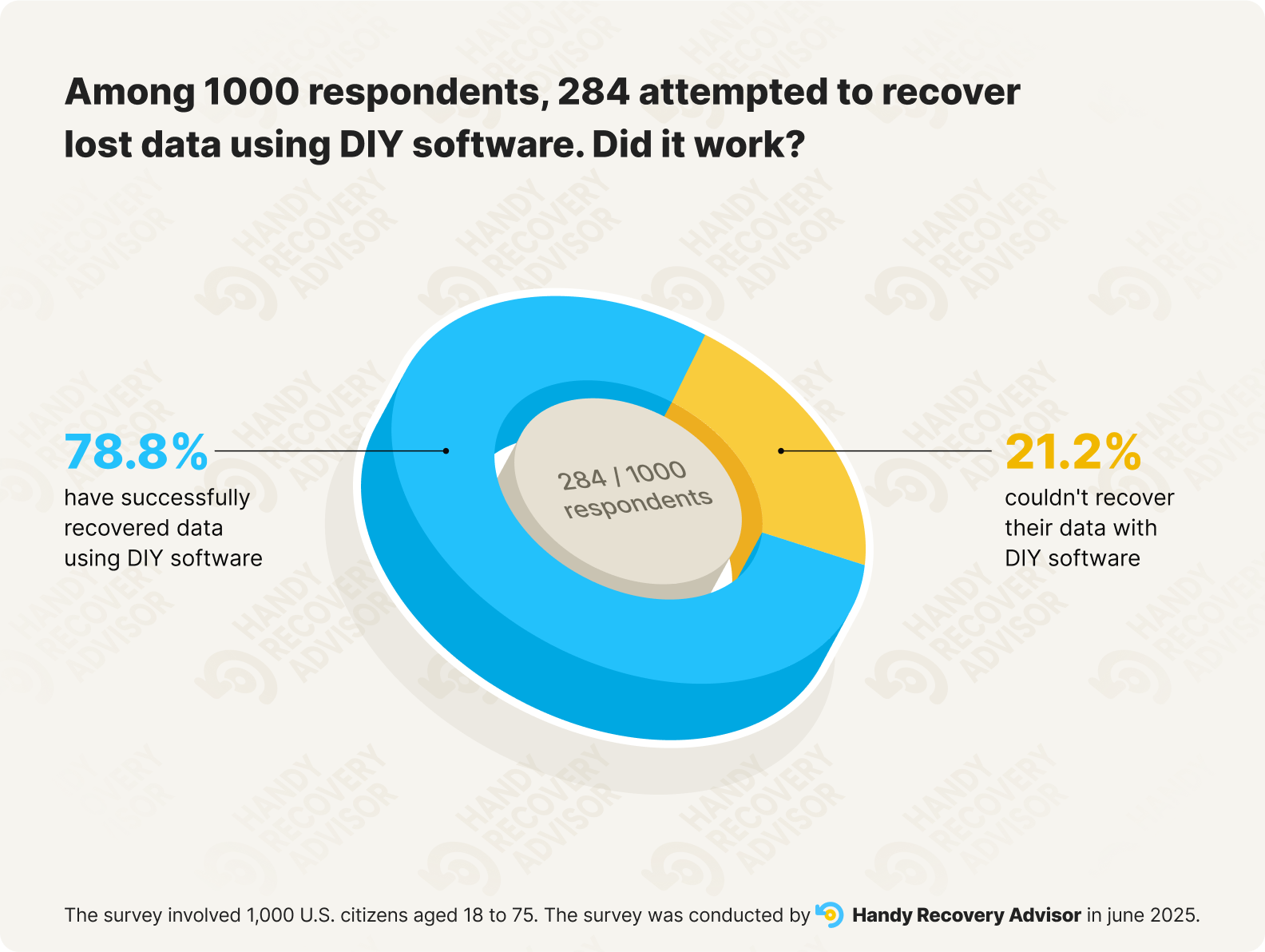
So while not everyone attempts recovery this way, those who do often walk away with their files. It’s a reminder that the tools work more often than people might expect; they just have to be properly used.
11. Roughly 33% of respondents are willing to pay for recovery if the data’s worth it
As to non-DIY recovery, about a third of users (329 people) said they’d pay for data recovery, but only if the lost data is truly important. Another 36% are open to the idea, though price plays a big role in their decision. For 25%, it depends on what kind of data was lost. And only 6% flat-out said they wouldn’t pay or would only look for free options.

So while most people see value in professional recovery, the willingness to spend isn’t automatic. It ties into a question we hear all the time: How much does data recovery cost? And the answer is: enough to make people hesitate unless the files really matter. Most users see the value, but they weigh it carefully against what they lost.
12. Tech proficiency doesn’t correlate with data loss accidents
This one flipped expectations. When we looked at users who’ve never lost data, beginners actually had the best track record. That number dropped as skill level went up:
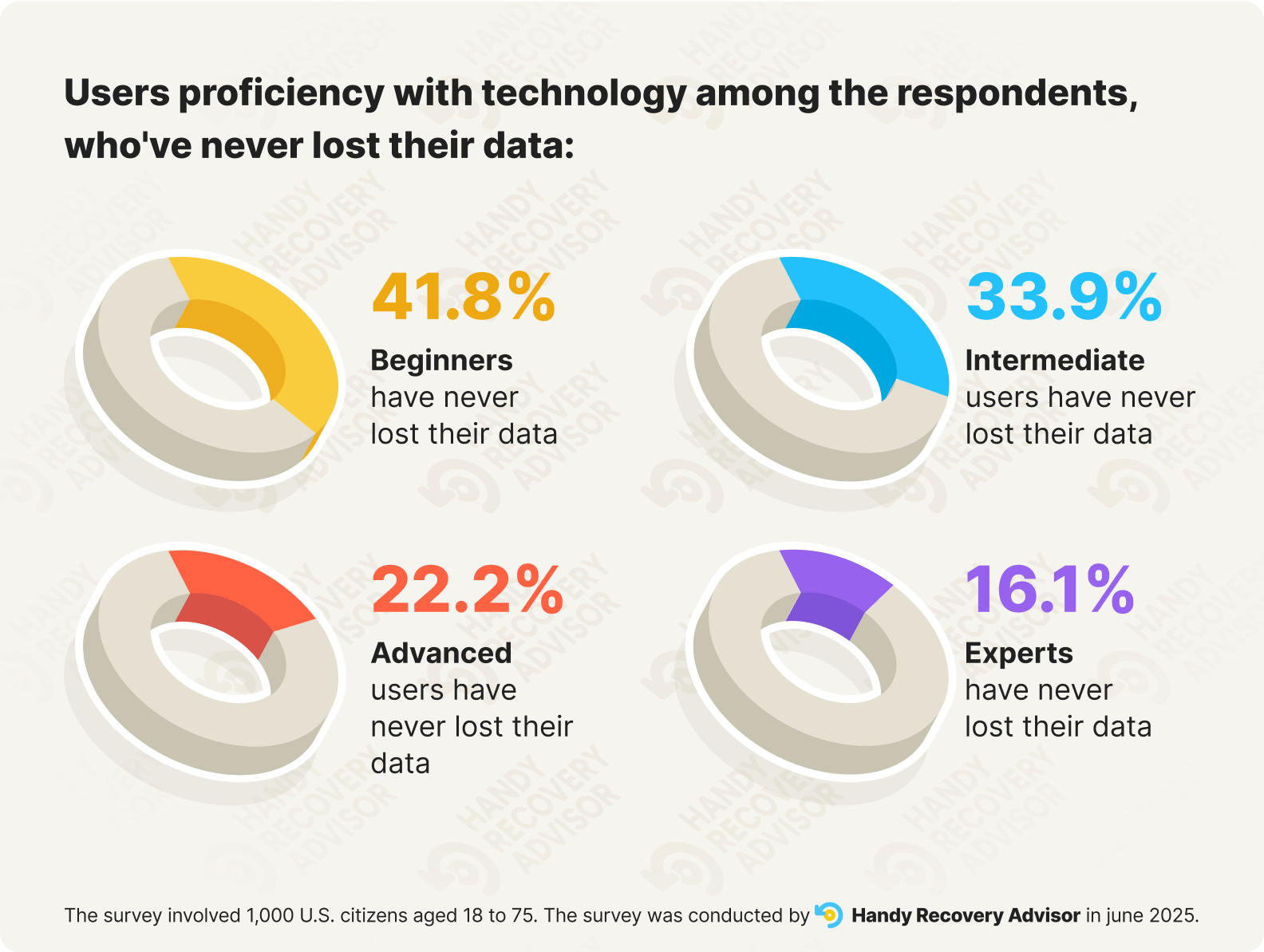
At first, these numbers might seem weird, but take into account that experts and advanced users usually handle way more data, juggle multiple devices, and get into more complex tasks. They’ve also likely been at it for much longer, which naturally increases their exposure to data loss risks over time. So while they may know more, they’re also in riskier territory more often.
Conversely, beginners’ limited usage may actually work in their favor (at least in the context of data loss prevention statistics).
Survey’s Methodology
Before we wrap up, a few words about our data loss survey. We collected responses through a survey launched on the PollFish platform on June 24, 2025. The survey included 1,000 U.S. nationals from various states and age groups (18 to 75), with millennials and Gen X making up the majority. Most respondents (over 80%) considered themselves Intermediate or Advanced users when it comes to tech skills.
That said, their backgrounds varied widely, from tech and IT professionals to creative industries, government, and the private sector; otherwise, our data loss statistics would be skewed. This broad mix allowed us to get a clearer, more accurate picture of how people truly approach data loss prevention in real life.
In order not to unintentionally shape a narrative, we featured multiple-choice, rating-scale, and multi-select questions. This approach helped us capture honest responses and avoid leading participants toward any specific answers.
This article was written by Roman Demian, a Content Editor and QA Specialist at Handy Recovery Advisor.
Curious about our content creation process? Take a look at our Editor Guidelines.
